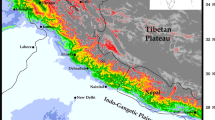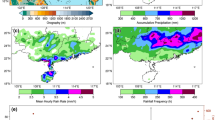Abstract
The heavy rainfall caused by interactions between the monsoon depression and the middle-latitude systems in Australia has been investigated in this paper. For a better understanding of the Australian monsoon depression (AMD) and its synoptic-scale interaction with the middle-latitude systems, some key meteorological parameters have been calculated, including the vorticity budget, moisture budget, temperature advection, frontogenesis function and potential vorticity. The results show that interaction between the lower and mid-latitude systems does exist leading to the merging of the extratropical low with frontal systems and the AMD, meanwhile both the low-level cold air from the mid-latitude and the warm moist air that was lifted by the front were very favorable for the formation and the intensification of heavy rainfall, which was quite different from the rainfall caused by the AMD alone. Second, the obvious temperature advection and gradient were detected, so the baroclinicity was favorable to the intensification of the front, as well as to the development of the upper-level jet. Next, isentropic analysis revealed that the south-west cold-flow sank and met the warm flow coming from the northern part of Australia, thereby forming the obvious baroclinic zone in the lower troposphere. A high-PV anomaly area located in the upper level of the troposphere, which overlaid the low-level frontogenesis zone, also existed. The upper-level PV maximum extended downwards forming a vertical PV column when the extratropical low intensified. Furthermore, the AMD is a warm-cored vortex located in middle and upper troposphere with a deep and thick moisture layer, and there were some differences in the vorticity and moisture budgets of the two different stages. Finally, based on the above-mentioned analysis, a conceptual model describing the interactions between the lower and middle-latitude systems in the southern hemisphere was proposed.

























Similar content being viewed by others
References
Daggupaty SM, Sikka DR (1977) On the vorticity budget and vertical velocity distribution associated with the life cycle of a monsoon depression. J Atmos Sci 34:773–792
Davidson NE (1995) Vorticity budget for AMEX, Part I: diagnostics. Mon Weather Rev 123:1620–1635
Davidson NE, Holland GJ (1987) A diagnostic analysis of two intense monsoon depression over Australia. Mon Weather Rev 115:380–392
Doty BE (1995) Grid analysis and display system (GrADS). Center for Ocean-Land-Atmosphere Interaction, Institute for Global Environment and Society, Calverton, MD, 148 pp
Godbole RV (1977) The composite structure of the monsoon depression. Tellus 29:5–40
Hell RM, Smith RK (1998) A monsoon depression over northwestern Australia. Part I: case study. Aust Meteorol Mag 47:21–40
Holland GJ, McBride JL, Smith RK, Jasper D, Keenan T (1986) The BMRC Australian monsoon experiment: AMEX. Bull Am Meteorol Soc 67:1466–1472
Hoskins BJ, McIntyre ME, Robertson AW (1985) On the use and significance of isentropic potential vorticity maps. Quart J Roy Meteorol Soc 111:877–946
Kalnay E, Kanamitsu M, Kistler R, Collins W, Deaven D, Gandin L, Iredell M, Saha S, White G, Woollen J, Zhu Y, Leetmaa A, Reynolds R (1996) The NCEP/NCAR 40-Year reanalysis project. Bull Am Meteorol Soc 77:437–471
Kato K (1985) On the abrupt change in the structure of the Baiu front over the China continent in late May of 1979. J Meteorol Soc Jpn 63:20–35
Krishnamurti TN, Kanamitsu M, Godbole R, Chang CB, Carr F, Chow JH (1975) Study of a monsoon depression (I), synoptic structure. J Meteorol Soc Jpn 53:227–239
Krishnamurti TN, Kanamitsu M, Godbole R, Chang CB, Carr F, Chow JH (1976) Study of a monsoon depression (II), dynamical structure. J Meteorol Soc Jpn 54:208–225
Nitta T, Masuda K (1981) Observational study of a monsoon depression developed over the Bay of Bengal during summer MONEX. J Meteorol Soc Jpn 59:672–682
Nitta T, Murakami M (1980) Three dimensional structure and energy cycles of a monsoon depression developed over the Bay of Bengal. FGGE Oper Rep 9:137–144
Palmen E (1958) Vertical circulation and release of Kinetic energy during the development of Hurricane Hazel into an extratropical storm. Tellus 10:1–23
Qi LX, Leslie LM, Zhao SX (1999) Cut-off low pressure systems over southern Australia: climatology and case study. Int J Climatol 19:1633–1649
Rossby CG (1937) Isentropic analysis. Bull Am Meteorol Soc 18:201–209
Shibagaki Y, Ninomiya K (2005) Multi-scale interaction processes associated with development of a sub-synoptic-scale depression on the Meiyu-Baiu frontal zone. J Meteorol Soc Jpn 83(2):219–236
Tao SY, Chen LX (1987) A review of recent research on the East Asian summer monsoon in China. In: Chang CP, Krishnamurti TN (eds) Monsoon meteorology. Oxford University Press, pp 60–92
Uccellini LW (1976) Operational diagnostic applications of isentropic analysis. Nat Weather Digest 1:4–12
Zeng QC, Zhang BL, Liang YL, Zhao SX (1994) East Asian monsoon—a case study. Proc Indian Nat Sci Acad 69A(100):81–96
Zhang F, Zhao SX (2004) A study of formation and development of one kind of cyclone on the Mei-yu (Baiu) Front. Adv Atmos Sci 21(5):741–754
Zhao SX, Mills GA (1991) A study of a monsoon depression bringing record rainfall over Australia. Part II: synoptic diagnostic description. Mon Weather Rev 119:2074–2094
Zhao SX, Sun JH (2007) Study on cut-off low-pressure systems with floods over Northeast Asia. Meteorol Atmos Phys 96:159–180
Zhao SX, Zeng QC (2005) A study of east Asia strong cold wave-surge crossing equator and influencing the development of tropical cyclone and heavy rainfall in the southern hemisphere. Clim Environ Res 10(3):507–525 (in Chinese)
Acknowledgments
This study was supported by the project of the National Key Basic Research and Development of China (No. 2009CB421401) and the project of the National Natural Science Foundation of China (No. 40930951). The authors would like to thank Dr. Lixin Qi, Australian Bureau of Meteorology, Melbourne, Australia, for his valuable discussions and important assistance.
Author information
Authors and Affiliations
Corresponding author
Rights and permissions
About this article
Cite this article
Kong, Q., Zhao, S. Heavy rainfall caused by interactions between monsoon depression and middle-latitude systems in Australia: a case study. Meteorol Atmos Phys 106, 205–226 (2010). https://doi.org/10.1007/s00703-010-0060-5
Received:
Accepted:
Published:
Issue Date:
DOI: https://doi.org/10.1007/s00703-010-0060-5




